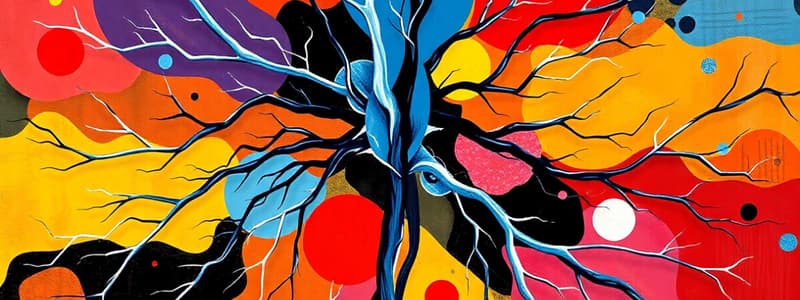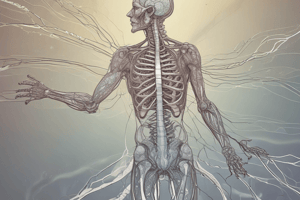Podcast
Questions and Answers
What are the two main divisions of the nervous system?
What are the two main divisions of the nervous system?
- Central Nervous System and Peripheral Nervous System (correct)
- Somatic Nervous System and Autonomic Nervous System
- Sympathetic Nervous System and Parasympathetic Nervous System
- Cranial Nerves and Spinal Nerves
Which of the following correctly defines the autonomic nervous system?
Which of the following correctly defines the autonomic nervous system?
- Controls voluntary movements of skeletal muscles
- Regulates the sensory input to the brain
- Operates involuntarily, controlling smooth and cardiac muscle movements (correct)
- Is only responsible for reflex actions in the body
How many pairs of cranial nerves are present in humans?
How many pairs of cranial nerves are present in humans?
- 8 pairs
- 12 pairs (correct)
- 14 pairs
- 10 pairs
What is the primary function of the sympathetic nervous system?
What is the primary function of the sympathetic nervous system?
Which segment of the spinal cord has the highest number of segments?
Which segment of the spinal cord has the highest number of segments?
What component is NOT part of the reflex arc?
What component is NOT part of the reflex arc?
Which characteristic differentiates the somatic nervous system from the autonomic nervous system?
Which characteristic differentiates the somatic nervous system from the autonomic nervous system?
What type of reflex action is considered autonomic?
What type of reflex action is considered autonomic?
What type of reflex arc is primarily involved in voluntary muscle control?
What type of reflex arc is primarily involved in voluntary muscle control?
Which statement correctly describes the lateral ganglia of the sympathetic nervous system?
Which statement correctly describes the lateral ganglia of the sympathetic nervous system?
What is the primary chemical transmitter in all autonomic ganglia?
What is the primary chemical transmitter in all autonomic ganglia?
What functions do terminal ganglia primarily serve?
What functions do terminal ganglia primarily serve?
What is a key function of the autonomic ganglia?
What is a key function of the autonomic ganglia?
Which system primarily regulates involuntary actions such as heart rate and digestion?
Which system primarily regulates involuntary actions such as heart rate and digestion?
What is a major effect of sympathetic stimulation to the salivary glands?
What is a major effect of sympathetic stimulation to the salivary glands?
Which of the following best describes collateral ganglia?
Which of the following best describes collateral ganglia?
Which of the following is NOT a sign associated with Horner's syndrome?
Which of the following is NOT a sign associated with Horner's syndrome?
What is the effect of sympathetic stimulation on the heart?
What is the effect of sympathetic stimulation on the heart?
What leads to the sinking of the eyeball in Horner's syndrome?
What leads to the sinking of the eyeball in Horner's syndrome?
What is the primary origin segment for sympathetic supply to the abdomen?
What is the primary origin segment for sympathetic supply to the abdomen?
Which physiological response occurs due to sympathetic stimulation of the gastrointestinal tract?
Which physiological response occurs due to sympathetic stimulation of the gastrointestinal tract?
What are the hormones secreted by the suprarenal medulla during sympathetic activation?
What are the hormones secreted by the suprarenal medulla during sympathetic activation?
Which of the following statements about the enteric nervous system (ENS) is false?
Which of the following statements about the enteric nervous system (ENS) is false?
Which of the following effects is associated with vasoconstriction of blood vessels?
Which of the following effects is associated with vasoconstriction of blood vessels?
What is the primary function of the sympathetic nervous system's innervation to the urinary bladder?
What is the primary function of the sympathetic nervous system's innervation to the urinary bladder?
Which segments of the spinal cord provide sympathetic innervation to the upper limbs?
Which segments of the spinal cord provide sympathetic innervation to the upper limbs?
Which of the following describes 'Orbeli’s phenomenon'?
Which of the following describes 'Orbeli’s phenomenon'?
What triggers a mass discharge of the sympathetic nervous system (SNS)?
What triggers a mass discharge of the sympathetic nervous system (SNS)?
What is the primary effect of sympathetic stimulation on the skin?
What is the primary effect of sympathetic stimulation on the skin?
Flashcards
Central Nervous System (CNS)
Central Nervous System (CNS)
The central part of the nervous system, comprising the brain and spinal cord.
Peripheral Nervous System (PNS)
Peripheral Nervous System (PNS)
The nerves that connect the CNS to the rest of the body.
Somatic Nervous System
Somatic Nervous System
Part of the nervous system that controls voluntary movements of skeletal muscles.
Autonomic Nervous System (ANS)
Autonomic Nervous System (ANS)
Signup and view all the flashcards
Sympathetic Nervous System
Sympathetic Nervous System
Signup and view all the flashcards
Parasympathetic Nervous System
Parasympathetic Nervous System
Signup and view all the flashcards
Cranial Nerves
Cranial Nerves
Signup and view all the flashcards
Spinal Nerves
Spinal Nerves
Signup and view all the flashcards
Reflex Arc
Reflex Arc
Signup and view all the flashcards
Somatic Reflex
Somatic Reflex
Signup and view all the flashcards
Autonomic Reflex
Autonomic Reflex
Signup and view all the flashcards
Sympathetic Pelvic Supply
Sympathetic Pelvic Supply
Signup and view all the flashcards
Sympathetic Mass Discharge
Sympathetic Mass Discharge
Signup and view all the flashcards
Sympathetic Upper/Lower Limb Supply
Sympathetic Upper/Lower Limb Supply
Signup and view all the flashcards
Sympathetic Thoracic/Abdominal Wall Supply
Sympathetic Thoracic/Abdominal Wall Supply
Signup and view all the flashcards
Sympathetic Skin Effect
Sympathetic Skin Effect
Signup and view all the flashcards
Sympathetic Skeletal Muscle Effect
Sympathetic Skeletal Muscle Effect
Signup and view all the flashcards
Vasoconstriction
Vasoconstriction
Signup and view all the flashcards
Horner's Syndrome
Horner's Syndrome
Signup and view all the flashcards
Ptosis
Ptosis
Signup and view all the flashcards
Miosis
Miosis
Signup and view all the flashcards
Enophthalmos
Enophthalmos
Signup and view all the flashcards
Anhydrosis
Anhydrosis
Signup and view all the flashcards
Sympathetic Nervous System (SNS)
Sympathetic Nervous System (SNS)
Signup and view all the flashcards
Enteric Nervous System (ENS)
Enteric Nervous System (ENS)
Signup and view all the flashcards
Suprarenal medulla
Suprarenal medulla
Signup and view all the flashcards
Adrenaline
Adrenaline
Signup and view all the flashcards
Noradrenaline
Noradrenaline
Signup and view all the flashcards
Autonomic Ganglia
Autonomic Ganglia
Signup and view all the flashcards
Lateral Ganglia
Lateral Ganglia
Signup and view all the flashcards
Collateral Ganglia
Collateral Ganglia
Signup and view all the flashcards
Terminal Ganglia
Terminal Ganglia
Signup and view all the flashcards
Preganglionic Fibers
Preganglionic Fibers
Signup and view all the flashcards
Postganglionic Fibers
Postganglionic Fibers
Signup and view all the flashcards
Acetylcholine (ACh)
Acetylcholine (ACh)
Signup and view all the flashcards
Sympathetic Nervous System (SNS)
Sympathetic Nervous System (SNS)
Signup and view all the flashcards
Sympathetic to the Head and Neck
Sympathetic to the Head and Neck
Signup and view all the flashcards
Noradrenaline/Norepinephrine
Noradrenaline/Norepinephrine
Signup and view all the flashcards
Pupil Dilation
Pupil Dilation
Signup and view all the flashcards
Study Notes
Nervous System Overview
- The nervous system is functionally divided into somatic and autonomic systems.
- The somatic nervous system controls voluntary movements of skeletal muscles and relies on somatic fibers.
- The autonomic nervous system is involuntary and controls smooth and cardiac muscles, as well as gland secretions. It relies on autonomic nerve fibers.
Nervous System Divisions
-
Central Nervous System (CNS):
- Brain and Brain Stem:
- Composed of two cerebral hemispheres and the cerebellum.
- Includes the midbrain, pons, and medulla oblongata, part of the brain stem.
- Spinal Cord:
- Contains 31 segments (Cervical, Thoracic, Lumbar, Sacral, Coccygeal).
- Specific segment counts vary. e.g., Cervical contains 8 segments
- Brain and Brain Stem:
-
Peripheral Nervous System (PNS):
- Cranial Nerves: 12 pairs.
- Spinal Nerves: 31 pairs.
Reflex Arc Components
- Receptors: The initial point of stimulation.
- Afferent Neuron: Carries signals from receptors to the center.
- Center: The integration point in the CNS (e.g., spinal cord).
- Efferent Neuron: Carries signals from the center to the effector.
- Effector Organ: Responds to the signal (e.g., muscle).
Autonomic Ganglia
- Definition: Collections of nerve cells outside the CNS, where preganglionic and postganglionic autonomic fibers synapse.
- Chemical Transmitter: Acetylcholine (ACh) is the primary chemical transmitter in all ganglia.
- Types of autonomic ganglia:
- Lateral Ganglia (paravertebral):
- Primarily sympathetic.
- Lie alongside the vertebral column.
- An exception for cervical segments: They’re unified into three pairs (superior, middle, and inferior).
- Postganglionic fibers are long.
- Collateral Ganglia:
- Located between the sympathetic chain and the internal organs (viscera).
- Named based on the artery they're near (e.g., celiac, renal, superior/inferior mesenteric ganglia).
- Terminal Ganglia:
- Primarily parasympathetic.
- Situated near or within the target organ.
- Postganglionic fibers are short.
- Lateral Ganglia (paravertebral):
Functions of Autonomic Ganglia
- Relay station between preganglionic and postganglionic fibers.
- Distributing centers. Each preganglionic sympathetic neuron branches out to 8-12 postganglionic neurons.
- Sites at which many drugs (e.g., ganglion blockers) act.
Sympathetic Nervous System (SNS)
- SNS to the head & neck, origin: from thoracic (T1-T2) segments, relay: superior cervical ganglia, chemical transmitters: Acetylcholine (pre) & Norepinephrine (post).
- SNS to the thorax, origin: upper 4 thoracic segments, relay in thoracic and cervical ganglia, activities: heart stimulation (contractility, conduction, excitability), dilation of coronary blood vessels, widening of bronchi & bronchioles, decreased mucous secretions in lungs, vasoconstriction of pulmonary vessels
- SNS to the abdomen, origin: thoracic (T6-T12) segments, relay in collateral ganglia (celiac, renal, superior/inferior mesenteric), the part supplying the gut (enteric nervous system) acts on the GIT by relaxing smooth muscle of stomach, small intestine, and proximal colon. Stimulating glycogenolysis in liver and contraction of sphincters. Vasoconstriction of splanchnic arteries.
- SNS to the pelvis, origin: from the upper 2–3 lumbar segments (L1-L3), relay in inferior mesenteric ganglia, functions: Relaxation of bladder wall, contraction of internal urethral sphincter, relaxation of rectum wall and contraction at the internal anal sphincter, participation in sexual acts.
- SNS to the upper and lower limbs and thoracic abdominal walls, origin: Thoracic (T5-T9) upper limbs, thoracic and lumbar segments for lower limbs, thoracic and abdominal walls, relay in sympathetic chain ganglia. Functions: Sweat secretion, hair erection, vasoconstriction for the skin, vasodilation for skeletal muscles.
Orbeli Phenomenon
- Sympathetic stimulation leads to enhanced skeletal muscle contraction, delayed fatigue, and accelerated recovery from fatigue.
- This results from improved blood flow and enhanced sensitivity of motor end plates.
Mass Discharge of SNS
- SNS often discharges as a unit during emergencies/stress.
- This is commonly seen in circumstances like extreme exercise, fear, hemorrhage, or cold exposure.
- The response is widespread, preparing the body for fight-or-flight reactions.
Cranial Nerves
- The 12 pairs of cranial nerves have specific functions like olfactory (smell), optic (vision), oculomotor (eye movement), and more.
- Cranial nerves have both sensory and motor components.
Spinal Nerves
- Spinal nerves also have both motor and sensory functions.
- They consist of dorsal and ventral roots.
Enteric Nervous System (ENS)
- Part of the autonomic nervous system specifically for the gastrointestinal tract (GIT).
- Has its own intricate network of neurons to control digestive processes, independently regulating motility, secretions, and blood flow.
Horner's Syndrome
- A group of symptoms resulting in one-sided interruption of sympathetic nerve supply to the head and neck.
- Symptoms include ptosis (drooping of the eyelid), miosis (constricted pupil), enophthalmos (sunken eyeball), anhydrosis (lack of sweating), and warmth and redness of the skin.
- Usually due to lesions in cervical and/or first two thoracic ganglia
Autonomic Control of Organs
- Specific examples of autonomic control are presented for various organs (eyes, salivary glands, skin, heart, lungs, etc.). This describes the effects of sympathetic and parasympathetic stimulation on different bodily functions.
Studying That Suits You
Use AI to generate personalized quizzes and flashcards to suit your learning preferences.



